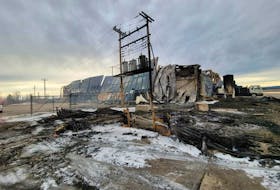Bob Byrnes, a Stephenville businessman, is complaining the pavement on the Hansen Highway laid last June is already cracking and an expert in the field of paving agrees it’s way too soon.
RELATED:
'Mayor and MHA elated with Hansen Highway roadwork and creek dredging'
Last week, while traveling over part of the nine kilometers of the Hansen Highway paved last summer, Byrnes said it hit him the side of the road is breaking up, then noticed center sections cracking up.
He said after fighting 20 years to have this road upgraded and paved, to witness this happening after seven months was shocking.
Byrnes immediately contacted John Finn, MHA for Stephenville–Port au Port, and asked him to investigate it.
“We, as a province, can’t afford to have this happen,” he said.
Kamal Hossain, assistant professor of pavement engineering at the Department of Civil Engineering at Memorial University, agrees the pavement shouldn’t be cracking that fast.
He recognized we’re in a small province with less revenue than some jurisdictions but said there is an urgent need to improve the design system of paving here.
“We need to have the pavement design and management system to suit the province. A huge amount of tax-dollars is spent on paving, so it should last,” he said.
Hossain, who is heading up a research team of eight master’s and doctoral researchers on pavement engineering at Memorial, started his research there in 2017.

Q. Why would the pavement be cracking in this nine km area just seven months after being put down?
A. In 2018, pavement should not be showing signs of cracking that quickly. The design system of paving has changed a lot in the last 20 to 30 years. It probably comes down to the mixture not being designed properly for the regional environment, and maybe the thickness is not proper for the traffic that is experienced in the road section.
Q. Would the problem be with the pavement itself or do it look like a subsurface problem?
A. From studying a couple of photos of the cracking, it looks like a failure of the pavement mixture. When winter started, due to low temperature, the pavement contracted and shrank. Thus, the contraction induced stress in pavement and nucleated micro-cracking. I’d strongly recommend the Department of Transportation and Work conduct forensic investigation to some level.
Q. Is there a difference between cracking near the shoulder of the road and the center of the road?
A. The longitudinal cracks are extending most likely due to the lack of proper mixture design.
Q. Considering this section of road was re-done completely with the old pavement removed, new culverts put in where needed and new gravel material in most parts of it, should this be happening?
A. It’s not imaginable it happened this fast. To my knowledge, the Department of Transportation and Works still use a 1940’s paving mixture design method called the Marshall Design System, which is no longer in the United States or parts of Europe who had moved to the 1990 Superpave Mix Design System, which is more scientific.
Q. Should government be going back to the company to get this problem fixed?
A. Government should have a mechanism in place if a road breaks in seven or eight months there is a proper explanation why it is occurring. With the answer we can learn to reduce this in future years.









